Where Does Coffee Come From?
Where does coffee come from? It may not be a question we ask as we stumble to the coffee maker first thing in the morning. But, perhaps, over a midday coffee break, we might begin to wonder about the origins of this magical elixir that fuels our lives. Coffee is more than just a beverage; it’s a global phenomenon that links cultures, economies, and individuals around the world. In this article, we will trace the journey of coffee, from the slopes of ancient Ethiopian highlands to your morning cup, exploring its history, cultivation, and influence across centuries.
The Coffee Plant: A Brief Overview
Adorning the branches of the coffee plant are its fragrant white blossoms and the iconic glossy, dark green leaves, which flaunt an oval shape extending up to 15 centimeters in length. The combination of sweetly scented flowers and robust greenery lends the coffee plant not only agricultural value but also an innate beauty that has captured the fascination of both coffee farmers and enthusiasts alike.
What is a Coffee Plant?
A coffee plant is an evergreen shrub or small tree that can stretch up to a majestic 5 meters tall when left unpruned. The plant’s foliage is characterized by pairs of dark green, glossy leaves, usually measuring between 10-15cm long and 6cm wide—optimal for efficient photosynthesis. The plant displays its beauty further during its flowering stage, with clusters of fragrant white flowers emerging in the axils of the leaves.
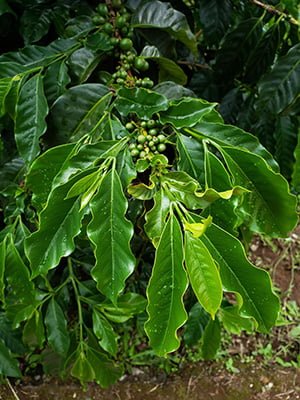
The coffee plant falls under the Rubiaceae family, with two primary species making the rounds in commercial cultivation: Coffea canephora, commonly known as robusta, and C. arabica. Inside the coffee cherry, one finds the seeds—commonly referred to as coffee beans—being patiently cultivated to undergo the transformation from green seed to the brown aromatic treasure that fills our cups.
Origins of the Coffee Plant
The coffee plant’s storied history is shrouded in mystery and rich anecdotal evidence, with the first credible accounts of coffee consumption dating back to mid-15th century Yemen. It was here where the concept of roasting and brewing coffee seeds first emerged—a method not unlike our current coffee preparation techniques. Historical records suggest that coffee may have reached Yemen via Ethiopia, traversing across the Red Sea where active trade routes once flourished.
Coffee’s introduction as a beverage is also tied to the region’s religious practices, specifically among Sufi devotees seeking to maintain alertness during their nocturnal rituals. Islamic scholar Ibn Hajar al-Haytami noted qahwa, a beverage derived from a tree in the Zeila region—part of present-day Horn of Africa. Moreover, it is said that Somali merchants from Berbera and Zeila were instrumental in exporting coffee from Ethiopia to Yemen—an act that would eventually pave the way for coffee’s journey across the globe.
The Importance of Coffee Cherries
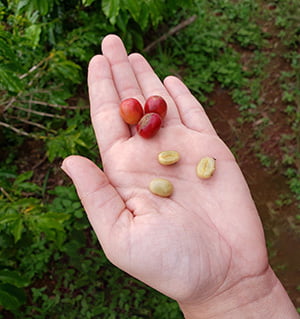
The coffee cherry is far more than a mere fruit—it is the vessel for the precious coffee beans that eventually become the highlight of our daily routine. Coffee cherries transition from a vivid green to a ripe red or purple hue, signaling their readiness for harvest. The timing of this harvest is paramount, as fully ripened cherries contain the potential for the richest and most flavorful coffee beans.
Carefully picked by hand or mechanically, depending on the region and resources, these cherries undergo processing—a critical stage that defines the coffee’s final taste. For instance, the dry processing method prevalent in Yemen contributes to a coffee that is deeply flavored and complex. Within each cherry are the seeds, or coffee beans, that after meticulous roasting, emerge as the aromatic brown beans ready to be ground and infused with hot water, culminating in the beloved cup of coffee savored by millions.
Discovery and Early History of Coffee
The enchanting elixir that rejuvenates millions worldwide, coffee, has a past steeped in legend and gradual worldwide embrace. Contrary to the bustling coffee shops and immense coffee plantations that now dot landscapes from Latin America to Asia, the journey of coffee began with a modest goat herder named Kaldi in 9th-century Ethiopia.
The Legend of Kaldi and the Dancing Goats
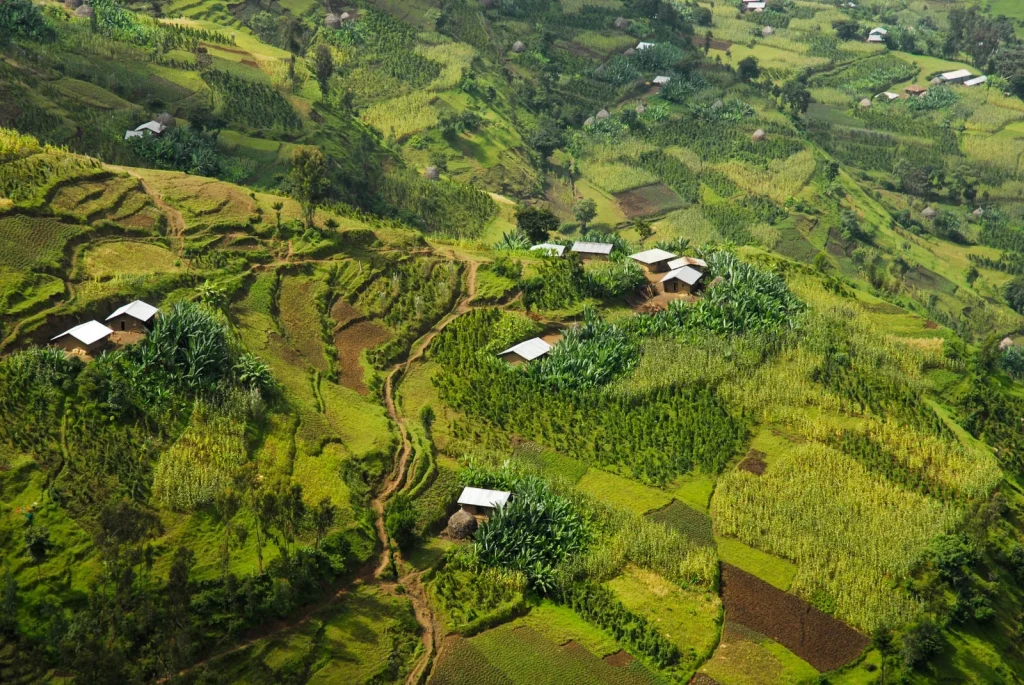
According to supposed Ethiopian folklore, the energizing power of coffee was first discovered inadvertently by Kaldi. Observing his goats prancing energetically after nibbling on the red berries of a particular bush, Kaldi was intrigued. He sampled these berries himself and was soon filled with a spirited vitality. This marked the inception of coffee’s use among local monks who used the berries to concoct a stimulating drink that aided their night-long prayers—an important chapter in the history of coffee that laid the groundwork for its future as a global stimulant.
This legend does not appear in ancient Arab sources, so it’s likely that it was developed by Western coffee makers and sellers. Or perhaps, early storytellers, sitting around a fire or maybe an early Turkish coffeehouse. Maybe someone asked, “where does this amazing elixir come from?” And a talented tall tale teller created the story of Kaldi and the Dancing Goats. It’s a great story, so it took hold and here we are centuries later! It IS a good story, but probably not as ancient as we’d like to imagine.
The Spread of Coffee to the Arabian Peninsula
But how did coffee transition from the Ethiopian highlands to the Arabian Peninsula? The period of the 15th century saw coffee make its landmark travel from the lush forests of Ethiopia to the soil of Yemen, where fertile lands on the Arabian Peninsula facilitated its cultivation. This critical geographical shift solidifies Yemen not just as a hub for coffee trade but as the birthplace of controlled agriculture of the coffee plant, significantly enhancing its scope and scale. The popular qahveh khanehs, or coffeehouses, sprang up in cosmopolitan hubs such as Persia, Egypt, Syria, and Turkey throughout the 16th century, rapidly transforming these public coffee houses into societal fulcrums of intellectual discourse and cultural exchange.
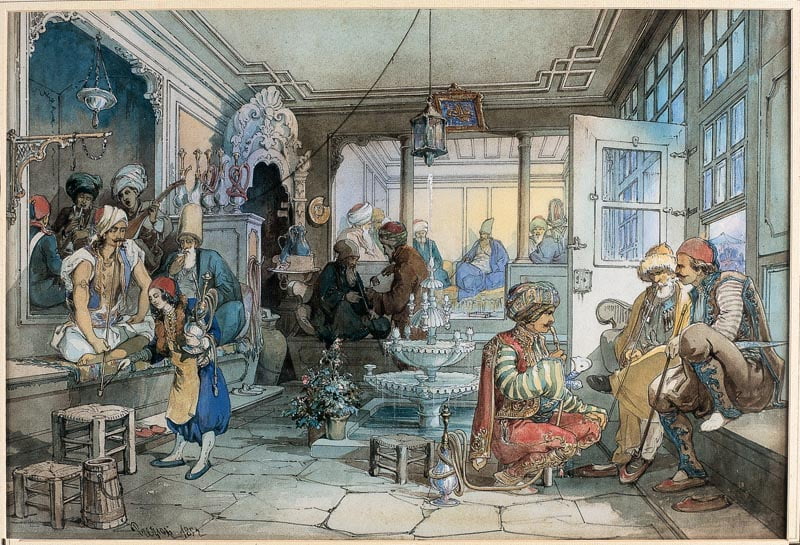
Coffee in the Islamic World
Coffee’s imprint on Islamic society was robust. The establishment of qahveh khanehs deepened its cultural entrenchment. These establishments burgeoned as intellectual salons, later known as “Schools of the Wise,” where the exchange of information, discussion of politics, and community engagement were customary. Annual pilgrimages to Mecca further contributed to coffee’s fame, with pilgrims spreading the allure of the bean far beyond Arabia. Coffee’s unique position in Islamic society shapes its narrative as not merely a commodity but a catalyst for socializing and scholarly pursuits.
Coffee’s Introduction to Europe
The aroma of coffee wafted into Europe through various avenues, each telling its own story of cultural exchange and conquest. The Siege of Vienna in 1529 and the Battle of Mohács in 1526 were key events in introducing the coffee beverage to the Europeans, with the latter marking Hungary’s first taste of this novel drink. Meanwhile, Venetian merchants, who frequently engaged with the Middle East, introduced coffee to their compatriots, laying the foundation for the first coffee house in Venice. By the late 17th century, these aromatic beans had crossed through the straits of global trade from the ports of Yemen to the vibrant streets of Europe’s most prominent cities, establishing coffee as the c force of social encounters we recognize today.
The trajectory of coffee is as rich and intricate as the drink itself, with each twist and turn of its discovery and history, adding depth to our understanding of this ubiquitous beverage. From Kaldi’s goats to the grand coffee houses of Europe, the tapestry woven by the journey of coffee is undeniably diverse and fascinating, underscoring its timeless appeal and integral role in shaping cultures across centuries.
Coffee Cultivation and Production
Coffee, once discovered, necessitated an evolution in its cultivation methods to meet the burgeoning global demand. In the germination phase, coffee cultivation traditionally saw around 20 seeds nestled in a single hole during the rainy season. Yet, with an average loss rate of 50% due to non-germination, more efficient techniques became paramount. To offset this loss, nurseries were established to raise robust coffee seedlings, which were then planted, leading to more successful crop yields.
In the initial years of a coffee plant’s life, intercropping with food crops such as corn, beans, or rice is a widespread practice. This not only maximizes land use but also assists coffee farmers in acclimatizing to the plant’s cultivation requirements. Moreover, the practice can enhance soil fertility and provide food security for the growers.
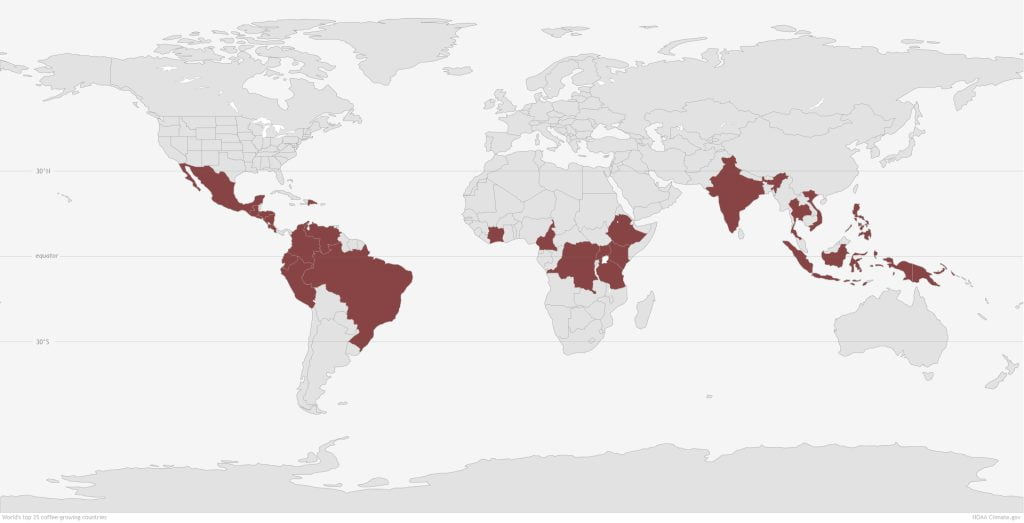
The gobbling thirst for coffee across the world is evident in the staggering production figures. In 2020, the global production of green coffee beans reached an impressive sum of approximately 175,647,000 60-kg bags. The coffee belt, an equatorial band lying between the tropics of Cancer and Capricorn, is the nurturing ground for coffee plants. It is in these latitudes that ideal conditions for coffee cultivation are met, with balanced sunshine, appropriate rainfall, and the quintessential rich soil contributing to the thriving growth of coffee plants.
Once the coffee cherries mature, ripening to a deep red, the labor-intensive harvesting begins. Although traditional methods like selective picking are still prevalent, especially in regions where the terrain is inhospitable to machines, in large producing countries such as Brazil, the mechanization of this process is increasingly common. The harvested coffee cherries then embark on a journey of processing which ultimately endows us with the beloved coffee beans ready for roasting.
Coffee Plantations in the Americas
By the mid-18th century, the rich tapestry of coffee cultivation had threaded its way into Latin America. Vast tropical forests were re-purposed for establishing expansive coffee plantations, creating a new agricultural legacy in the region. Among these countries, Brazil boasts the title of the world’s largest coffee producer, cultivating both Arabica and Robusta coffee beans across its vast landscapes of plantations.
Coffee plantations in Latin America not only contribute significantly to the global market but also to the coffee culture, with each country offering distinct flavor profiles. Colombia, known for its premier Colombian Supremo, delivers a delicate, aromatic sweetness while Excelso Grade presents a softer, slightly more acidic taste. Meanwhile, Guatemalan coffee carries the allure of rich chocolate tones differentiating it within the mosaic of Latin America’s offerings. Brazilian coffee strikes with its clarity, sweetness, and medium-bodied palate comprised of low-acid notes, a testimony to Brazil’s optimal coffee-growing conditions.
Importance of Central and South America in Coffee Production
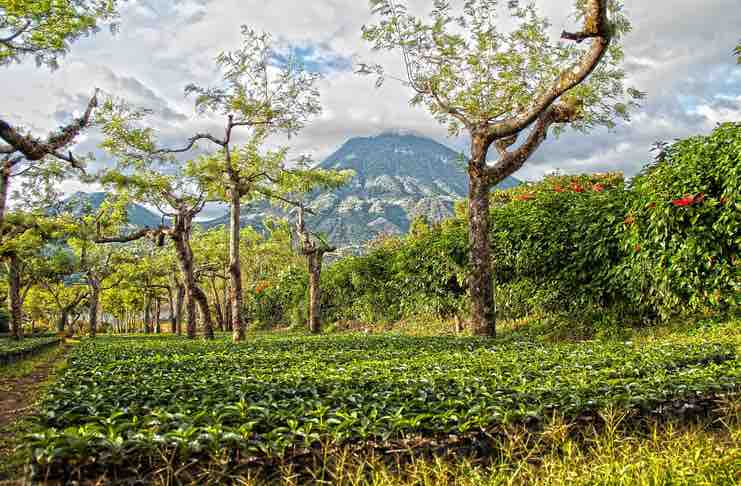
Central and South America’s role in global coffee production cannot be overstated. Colombia, with signature fruity tones, Guatemala, known for chocolatey richness, and Brazil, with its creamy nuttiness that excels in espresso, all highlight the diverse profiles influenced by the impeccable growing conditions of these regions. These nations provide a confluence of balanced sunshine, rain, and high humidity, supplemented by fertile soil, all of which elevate them to the status of top coffee producers.
Regions within Guatemala such as Antigua, Coban, and Huehuetanango are revered for imparting coffees with indelibly rich flavors and ranging from medium to full-bodied with either spicy or chocolatey complexity. Costa Rica carves its niche by exclusively producing wet-processed Arabica beans, revealing a commitment to high-quality coffee production methods. The emergence of coffee plantations in the 18th century throughout Central America capitalized on the hot, tropical climate conducive to coffee cultivation and transformed these regions into pivotal coffee-producing territories.
The Role of Coffee Farmers and Producers
Coffee farmers play a critical role in the lifecycle of coffee. By nurturing the coffee plants from germination indoors to planting them in fields, these farmers invest years before the plants commence fruit-bearing, usually taking from 3 to 4 years. The coffee plants, if tended with care and expertise, can become a lasting part of the farm’s landscape, remaining profitable for decades, with some plants bearing fruit for over a century.
The harvesting of coffee cherries at peak ripeness is an art that encapsulates the coffee’s purest flavor nuances. Farmers employ methods such as strip picking or selective picking, the latter often necessitating meticulous labor and precision. The challenges coffee farmers confront are multifaceted—from protecting plants against pests and providing necessary nutrients and water, to biding time for the optimal harvest period. Their labor is a testament to the dedication required to produce each cup of coffee savored around the world.
Different Varieties of Coffee Beans
Coffee beans are as varied as the regions they originate from, with over 120 identified varieties of the coffee plant. However, it is the Arabica and Robusta beans that command most of the global coffee consumption, either as pure strains or in harmonious blends. Arabica beans, known for their sweet and soft profile with a symphony of fruity, floral, chocolatey, and nutty notes, have a lineage that can be traced back 1,000 years BC.
The kaleidoscope of coffee flavors is inextricably linked to the cultivation environment—tropical, mountainous regions at high altitudes prime the beans to develop distinct characteristics. Factors like the local climate, elevation, and soil type can significantly shape the taste profile of the coffee, creating a boundless spectrum of flavors for enthusiasts to explore and savor.
The Coffee Market and Industry
As you traverse the diverse landscape of global agriculture, coffee stands out as a prime commodity. As of 2023, Brazil’s reputation as the world’s leading coffee supplier remains unchallenged, contributing a substantial 35% to the global supply. But Brazil isn’t the industry’s sole titan. In the year 1999, Vietnam surged to second place, holding 15% of the market share by 2011. The plentiful bounty of coffee beans grown globally feeds into an industry valued at a staggering $495.50 billion as of 2023, reflecting humanity’s unremitting love affair with this aromatic beverage.
The “Bean Belt”, encompassing lands snuggled close to the equator, cultivates the bulk of the world’s coffee, thanks to its perfect mix of sunshine, rainfall, and temperature. In this lush strip, countries like Colombia with its renowned smooth, mild beans, Ethiopia – the birthplace of coffee with its exotic varieties, Vietnam, and Indonesia each contribute their unique chapters to the story of coffee.
The Global Coffee Market: Overview and Trends

The voracity of global coffee consumption has doubled in a distinct period, much to the joy of Latin American countries and coffee producers around the world. Since 1852, Brazil has been at the vanguard as the preeminent coffee cultivator. While the nation continues to reign, the coffee-growing tapestry has expanded to welcome other key players like Colombia, the Ivory Coast, Ethiopia, and notably Vietnam since its ascension in 1999.
While traditional coffee drinks remain popular, the tides of taste have brought sugary concoctions such as lattes and Frappuccinos to the forefront. This shift has promulgated the use of less expensive coffee beans by coffee houses to balance out the cost of these widely cherished drinks. Coffee’s ascendancy from an Asian ritual to a global phenomenon mirrors the plant’s own journey from the Ethiopian highlands to plantations across the equator.
The International Coffee Organization
The International Coffee Organization (ICO) stands as a beacon in the coffee industry, steering the complex network of production and trade. It underscores the historical and economic facets of coffee, reflecting its international gravitas. With consumption present in a multitude of countries and the trade extending through multifarious channels, the coffee industry denotes an intricate fabric commencing from cultivation to worldwide distribution.
Impact of Coffee Production on Local Economies
If we peer beyond the multi-billion-dollar global sales, a poignant narrative emerges for coffee bean producers, many who grapple with poverty. Geographical and infrastructural elements gravely influence coffee pricing. For instance, the high cost of Colombian coffee in pre-1990 times was attributed to inadequate infrastructure in South and Central America. Meanwhile, contemporary Hawaiian coffee reflects high price tags, a by-product of isolated growing areas, costly labor, and extensive transportation to the US mainland. These production dynamics consequently fuel a discourse on the ramifications to local economies, with poverty among farmers, high costs, and market accessibility challenges at the fore.
The Role of Coffee Roasters and Retailers
Coffee roasters are more than mere middlemen; they are curators of experience and quality. With an increasing trend towards traceability, many roasters are forging direct relationships with coffee producers. This not only fortifies the supply chain but also helps maintain the integrity of fair trade practices. The roasting process, particularly for specialty coffees, may involve separating premium beans to preserve distinct flavors—further adding to cost. Moreover, some elite coffees make their way into internet auctions or competitions judged by an array of local and international connoisseurs. Once the perfect roast is achieved, these beans find new homes on shelves in grocery stores, cafes, and a variety of retail outlets, ready for consumption by eager coffee aficionados.
Types of Coffee and Brewing Methods
As any coffee enthusiast may tell you, the journey to a perfect cup of coffee begins with the beans. Coffee’s biodiversity is quite extensive, but at its core, there are four main types of coffee beans: Arabica, Robusta, Liberica, and Excelsa. Arabica and Robusta are the coffee world’s staples, making up the majority of coffee production globally.
Arabica beans, known for their smooth, complex flavor and aromatic sophistication, come from the Coffea Arabica plant, originally found in the highlands of Ethiopia. These beans are prized for their diverse flavor profiles, which can range from sweet and fruity to sharp and tangy. Despite being more delicate and requiring higher altitudes and cooler climates, consumers consistently seek out Arabica for its quality.
In contrast, Robusta beans come from the Coffea canephora plant and pack a punch with their robust flavor and higher caffeine content. They offer a stronger and more bitter taste, lending themselves well to espresso blends where their rich crema is highly appreciated. Robusta beans are hardy, less susceptible to pests, and can thrive at lower altitudes in warmer climates.
Liberica and Excelsa, relatively rare in comparison, offer unique flavors and are grown in specific regions. Liberica, with an often fruity and floral profile, and Excelsa, with its tart, fruity notes, both contribute to the incredible diversity within the coffee industry.
As coffee cherries grow on plants that could be considered as a hybrid between a shrub and a tree, they produce beans that are as varying as the regions they come from. Cultivated in over 70 countries, from Latin America to Southeast Asia and Africa, these beans not only feed into the global coffee culture but also reflect the essence of their terroir.
Popular Brewing Methods for Coffee
Brewing coffee is an art form, one that has been refined across cultures and centuries to cater to a plethora of taste preferences. Common brewing methods can be categorized into three primary actions: boiling, steeping, and pressurizing.

Boiling is one of the oldest methods and is exemplified by Turkish coffee. This style calls for a very fine grind that is simmered in a special pot, typically made of brass or copper, known as a cezve or ibrik. The result is a potent brew crowned with foam that contains settled grounds at the bottom of the cup—a testament to its full-bodied nature.
Steeping involves soaking the coffee grounds in water, allowing for a gradual extraction of flavors. This method includes approaches like the French Press where coarsely ground coffee is steeped in hot water before being separated by a plunger.
Pressurizing, the driving principle behind the popular espresso, utilizes high-pressure steam to draw out a concentrated shot of coffee. This method typically uses a fine grind and has led to a culture of baristas who experiment with pressure and temperature for that perfect espresso.
From the simplicity of a drip brewer to the regimented tradition of a siphon pot, the methods employed by coffee aficionados continue to evolve. Whether it’s the easy use of automatic coffeemakers or the patient ritual of pour-overs, each brewing method serves as a tribute to coffee’s versatile nature.
Exploring Various Coffee Blends and Roasts
The roasting of coffee beans is a transformative process, a ballet of heat and timing that turns the raw green coffee beans into the fragrant, brown pieces that we recognize. Starting off green, the beans pass through shades of yellow to light beige and, depending on the desired roast level, onto various degrees of dark brown before being rapidly cooled.
Arabica beans are often associated with lighter, sweeter roasts, while Robusta’s stronger, more assertive flavor lends itself to darker roasts. The precise roast level can emphasize different flavor notes and aroma compounds, making each batch of coffee unique.
Coffee aficionados worldwide enjoy blends that artfully combine Arabica and Robusta beans, balancing the latter’s bold character and caffeine kick with the former’s nuanced taste profile. These blends strike a harmonious balance that caters to all manners of palates.
As coffee beans traverse the globe from the leading growing regions in Brazil, Vietnam, and Colombia, they arrive at the roasters’ realm waiting to be crafted into a multitude of blends and roasts. Factors such as altitude, climate, and processing method contribute to the ordeal, sculpting the final taste.
In shops and cafes, the varieties of blends and roasts dazzle consumers. From single-origin specialty roasts that celebrate the unique qualities of their source locale to hearty and rich commercial blends, the coffee market offers an intricate tapestry of choices. This diversity ensures there’s a coffee out there for every taste, every morning ritual, every moment of reflection.
Environmental and Social Impact of Coffee Production
The cultivation of coffee is not just about producing the beans for a cherished beverage; it also has profound environmental and social implications. Climate change stands as a significant threat to this industry; research suggests the possibility of coffee production decreasing by as much as 50% by 2050, as rising temperatures and shifting weather patterns play havoc on coffee environments. These changing conditions underscore the urgency of incorporating sustainable practices into coffee farming.
On a social scale, coffee production can be riddled with ethical complexities. The history of coffee cultivation is deeply tied to slavery and oppression of people of color. Land owners, trading companies, and the colonial powers behind them, have used vulnerable people to enrich themselves. This continues across the globe as agricultural labor rights continue to be hard won, in contrast to the massive profits of the entire coffee production chain.
Fair Trade initiatives have been instrumental in securing the well-being of growers—particularly in impoverished areas—by advocating for fair compensation, forbidding child labor, and limiting the use of harmful agrochemicals. These efforts validate coffee as not only a commodity but also a means for societal improvement and justice.
In addition to these initiatives, a push for ecologically sound choices has taken root. Certifications such as those from Rainforest Alliance and Bird Friendly validate shade-grown coffees that support biodiversity, serving both the planet’s health and coffee lovers’ conscience.
Yet, it is important to remain aware of the nuanced environmental costs associated with coffee production, including the water utilized to grow coffee in fragile ecosystems like Ethiopia or the potential deforestation for new plantations in regions such as Vietnam’s Central Highlands. Also, the decaffeination process has its own set of environmental considerations with methods involving chemical solvents or carbon dioxide extraction.
Sustainable Coffee Farming Practices
Sustainable coffee farming practices offer a beacon of hope for addressing some of the environmental and social challenges facing the industry. Organic cultivation takes precedence under these practices, ensuring that the coffee we enjoy is free from synthetic fertilizers and pesticides, thereby safeguarding the health of farmworkers and the integrity of the land.
Coffee cherries, starting as semi-ripe fruits, are meticulously tended to and harvested once they reach their colorful peak, which varies from red to yellow based on the variety. This traditional approach includes planting unprocessed coffee seeds during the wet season, with roughly half of them germinating into healthy seedlings.
Among the practices, shade-grown coffee stands out for its ecological benefits. Not only does shade-grown coffee provide a haven for wildlife, but it also enhances coffee tree longevity, sometimes extending their lifespan up to 30 years. The Rainforest Alliance and Smithsonian Institute lend their stamps of approval, through certifications, to these endeavors, fostering a richer, more diversified habitat where coffee and nature coexist symbiotically.
Fair Trade Coffee and Ethical Consumerism
The fair trade movement, rooted in the late 1980s with initiatives like the Max Havelaar Foundation, aims to empower coffee growers through guaranteed minimum prices and community premiums for social projects. The fair trade coffee market has seen an upswing, with its global production increasing from 0.34% in 2004 to 0.51% in 2005—reflecting a growing consumer demand for ethically sourced products.
While fair trade has made notable strides, its overall impact has been a subject of debate, with some studies presenting mixed effects on the well-being of coffee-growing communities. Despite some skepticism, major coffee retailers like Starbucks have recognized the value of fair trade, introducing it to their stores in 2000 following advocacy by Global Exchange.
Ethical consumerism goes beyond just a stamp on a bag of coffee, promoting no use of child labor, the avoidance of dangerous pesticides, and fair wages for coffee producers. However, the enforcement of these standards often falls into controversial waters, challenging consumers to remain vigilant and informed about the origins of their coffee.
Coffee’s Impact on Biodiversity and Deforestation
Coffee’s journey from seed to cup does not come without its toll on the environment. Ethiopia, the birthplace of coffee, experiences substantial water use in coffee cultivation, affecting both local water resources and broader ecosystems. However, initiatives are in place to mitigate this impact; for instance, used coffee grounds can support biodiversity through composting, aiding worms and acid-loving plants.
Climate change generates concern for coffee yield viability, especially for areas like Nicaragua and Ethiopia, which could face severe decreases in suitable farmland. By 2016, at least 34% of global coffee production complied with voluntary sustainability standards, indicating a significant shift towards mitigating environmental impacts.
Coffee cultivation has historically led to deforestation, as seen in Vietnam’s Central Highlands, where the expansion of plantations has radically altered local biodiversity. These changes emphasize the crucial need for sustainable agriculture practices that prioritize forest conservation and biodiversity.
In consideration of these issues, consumers, producers, and policymakers are called to work together, striving for a balance between indulging in our beloved beverage and taking responsibility for the planet and people involved in its production.
- Where Does Coffee Come From? - March 29, 2024
- Stirring our Coffee - March 26, 2024
- Crafting the Perfect Keto Latte - March 25, 2024







